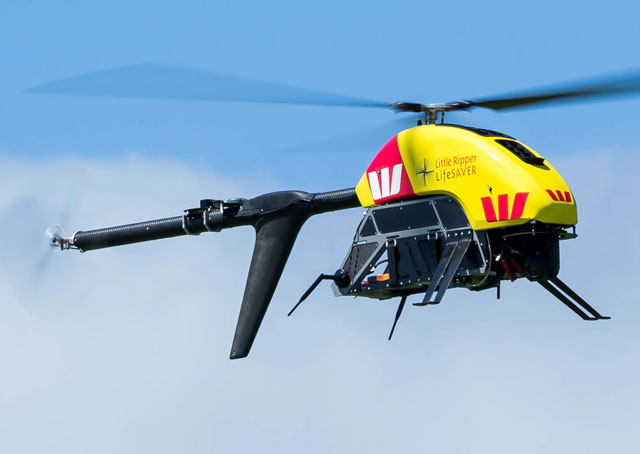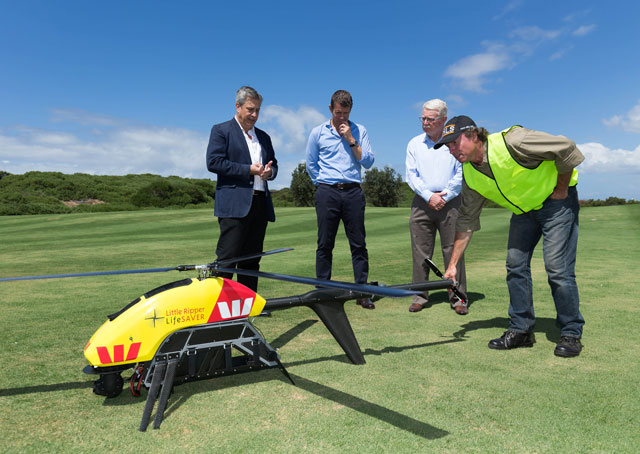
The Vapor 55 unmanned helicopter can execute precision maneuvers, carry payloads including trauma kits and life rafts, and do it all with minimal pilot intervention. The product of 12 years of development by Pulse Aerospace of Lawrence, Kansas, the helicopter demonstrated some of its capabilities and potential for battlefield rescue during a recent demonstration at the Camp Shelby Joint Forces Training Center in Hattiesburg, Mississippi, within a restricted airspace area that allowed an unmanned helicopter to maneuver autonomously.
The mission was designed in conjunction with Lt. Col. David King, who is a physician with the U.S. Army Joint Special Operations Command, a director of trauma research, and a professor of surgery at Harvard Medical School. The miniature helicopter, which can carry a 10-pound payload in addition to cameras, transponders, and sensors, was to deliver a kit with blood and other life-saving supplies to a wounded soldier. The mission was a success. The Vapor 55 flew four missions, each a 14-mile round trip, with flight times varying by less than 12 seconds, the unmanned helicopter’s maker reported in a January press release.
It would take more than a month before the Vapor 55 really caught the world’s eye, and that was thousands of miles away with an entirely different mission: spotting sharks and dropping life rafts in Australia.
New South Wales Premier Mike Baird declared it “the future of rescue” during a rollout ceremony for the Vapor 55 dubbed Little Ripper, which can be fitted with a marine version of the 10-pound rescue pod that carries a three-person inflatable life raft and emergency locator beacon. Pulse Aerospace’s Australian customers plan to deploy it for beach patrols spotting sharks, assigning Little Rippers to helicopter rescue bases funded by Westpac, the parent of various financial services firms and banks.
"The Little Ripper is the new, high-tech eye in the sky," Westpac CEO Brian Hartzer told the media during a February introduction of the aircraft. "There are 17 Westpac helicopters around Australia and we hope this is going to work really well and become another very welcome sight around the coastline.”
Pulse Aerospace CEO Aaron Lessig said the Vapor 55 can be scaled up significantly, though regulations and regulators in the United States have made this a challenge. The FAA currently limits unmanned aircraft operated in the National Airspace System to 55 pounds, and requires operators to keep those aircraft in sight at all times. Overseas, the potential for unmanned aircraft to carry larger payloads, including humanitarian relief and medical supplies, is being leveraged in Syria and Africa, among other places, and “we’re in the middle of that, too,” Lessig said.
“It’s very gratifying to spend 12 years developing technology and then seeing that being applied in situations where you can help people. The frustrating part [is] that help is being taken advantage of and used internationally but not in our home country,” Lessig said in a telephone interview. “We hope that will change soon.”
Lessig said the Vapor 55 has advantages over multirotor systems, including the ability to carry heavier payloads of both deployable items and onboard batteries that give it much longer flight times—two to five times as long as a multirotor system, with a payload that can also be two to five times heavier. A wide range of sensors, Automatic Dependent Surveillance-Broadcast transceivers, and sophisticated control systems also can be accommodated by the design. The cost is significantly higher than off-the-shelf products designed for consumers: The Vapor 55 basic system costs about $90,000, depending on how it is equipped.
Lessig said the Vapor 55 is not designed for consumers.
"We’re big proponents of strict regulation around UAVs,” Lessig said. “We believe that you’ve got to match the capability of the vehicle to what it’s allowed to do.”




